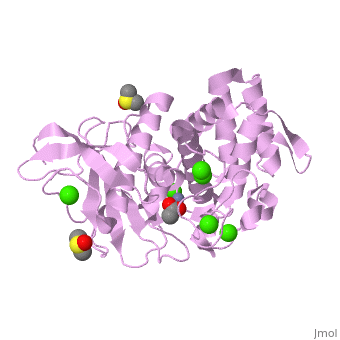Thermolysin
From Proteopedia
(Difference between revisions)
| Line 1: | Line 1: | ||
<StructureSection load='2a7g' size='400' side='right' scene= caption='Thermolysin complex with acetate, DMS, Zn+2 (grey) and Ca+2 (green) ions, [[2a7g]]'> | <StructureSection load='2a7g' size='400' side='right' scene= caption='Thermolysin complex with acetate, DMS, Zn+2 (grey) and Ca+2 (green) ions, [[2a7g]]'> | ||
| - | |||
| - | [[Image:2a7g.png|left|200px|thumb|Crystal Structure of Thermolysin [[2a7g]]]] | ||
| - | |||
| - | |||
| - | |||
| - | |||
| - | |||
| - | |||
| - | |||
| - | |||
| - | |||
| - | |||
| - | |||
| - | |||
| - | |||
| - | |||
| - | |||
| - | |||
| - | |||
| - | |||
| - | |||
| - | |||
| - | |||
| - | |||
| - | |||
| - | |||
| - | |||
[[Thermolysin]] (TML) is a thermostable metalloproteinase enzyme from ''Bacillus thermoproteolyticus''. It catalyzes the hydrolysis of peptide bonds containing hydrophobic residues. The images at the left and at the right correspond to one representative Thermolysin ([[2a7g]]). Thermolysin is a well researched [[metalloproteases|metalloprotease]] containing <scene name='User:Ralf_Stephan/Sandbox_2/Zinc/2'>zinc</scene> (click this!) and the amino acids His-Glu-X-His-His as its catalytic center. <scene name='User:Ralf_Stephan/Sandbox_2/Res_yellow/3'>Glu-166, His-142 and -146 are grouped around the zinc atom</scene>, holding it fast, while <scene name='User:Ralf_Stephan/Sandbox_2/Res/1'>Glu-143 holds the polarized water atom. Additionally, Tyr-157 and His-231</scene> stabilize the substrate protein which will be cleaved into two smaller proteins.<ref>Matthews, BW. (1988): ''Structural basis of the action of thermolysin and related zinc peptidases''. In: ''Acc. Chem. Res.'' '''21'''(9); 333–340; http://dx.doi.org/10.1021/ar00153a003</ref><ref>PMID:11935352</ref>. See [[Metalloproteases]] and [[Matrix metalloproteinase]] for discussion. | [[Thermolysin]] (TML) is a thermostable metalloproteinase enzyme from ''Bacillus thermoproteolyticus''. It catalyzes the hydrolysis of peptide bonds containing hydrophobic residues. The images at the left and at the right correspond to one representative Thermolysin ([[2a7g]]). Thermolysin is a well researched [[metalloproteases|metalloprotease]] containing <scene name='User:Ralf_Stephan/Sandbox_2/Zinc/2'>zinc</scene> (click this!) and the amino acids His-Glu-X-His-His as its catalytic center. <scene name='User:Ralf_Stephan/Sandbox_2/Res_yellow/3'>Glu-166, His-142 and -146 are grouped around the zinc atom</scene>, holding it fast, while <scene name='User:Ralf_Stephan/Sandbox_2/Res/1'>Glu-143 holds the polarized water atom. Additionally, Tyr-157 and His-231</scene> stabilize the substrate protein which will be cleaved into two smaller proteins.<ref>Matthews, BW. (1988): ''Structural basis of the action of thermolysin and related zinc peptidases''. In: ''Acc. Chem. Res.'' '''21'''(9); 333–340; http://dx.doi.org/10.1021/ar00153a003</ref><ref>PMID:11935352</ref>. See [[Metalloproteases]] and [[Matrix metalloproteinase]] for discussion. | ||
| - | |||
| - | {{TOC limit|limit=2}} | ||
== 3D Structures of Thermolysin == | == 3D Structures of Thermolysin == | ||
Revision as of 11:01, 20 August 2014
| |||||||||||
References
- ↑ Matthews, BW. (1988): Structural basis of the action of thermolysin and related zinc peptidases. In: Acc. Chem. Res. 21(9); 333–340; http://dx.doi.org/10.1021/ar00153a003
- ↑ Pelmenschikov V, Blomberg MR, Siegbahn PE. A theoretical study of the mechanism for peptide hydrolysis by thermolysin. J Biol Inorg Chem. 2002 Mar;7(3):284-98. Epub 2001 Sep 27. PMID:11935352 doi:http://dx.doi.org/10.1007/s007750100295
Created with the participation of Ralf Stephan.

